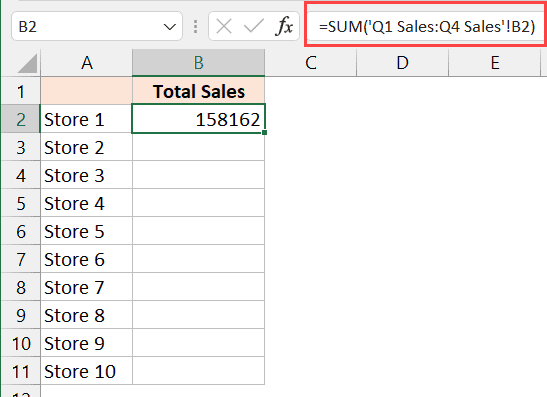5 Ways to Reference Data Across Excel Sheets

Excel's robust functionality is a dream come true for data analysts, accountants, and anyone dealing with large volumes of information. One of its core capabilities is the ability to reference data across multiple sheets within a workbook. This skill can significantly streamline your workflow and help you make sense of interconnected datasets. Here's how you can effectively leverage this feature in five distinct ways.
Method 1: Direct Sheet Referencing

Let's start with the most basic method. When you need to reference data from another sheet within the same workbook, you simply use the sheet name followed by an exclamation mark and the cell reference. Here’s how you do it:
- Open your Excel workbook.
- Select the cell where you want to display the reference.
- Type an equal sign (=), followed by the sheet name, an exclamation mark (!), and then the cell reference. For example, if you want to reference cell A1 from Sheet2, you would type
=Sheet2!A1.
🔍 Note: Ensure that you use the exact sheet name, which is case-sensitive in Excel. Spaces in sheet names should be replaced with underscores or kept as-is if you include them in single quotes.
Method 2: Using Excel Functions to Pull Data

For a more dynamic approach, Excel functions like VLOOKUP, INDEX, and MATCH allow you to reference and retrieve data from different sheets based on specific conditions or lookup values. Here are examples:
- VLOOKUP example: Assume you want to look up a product's price in a table located on another sheet named 'Products'. The syntax would be:
=VLOOKUP(product_id, Products!A1:B50, 2, FALSE) - INDEX and MATCH together for a two-way lookup:
=INDEX(Sheet3!A1:B50, MATCH(value_to_look, Sheet3!A1:A50, 0), MATCH(column_to_look, Sheet3!A1:B1, 0))
These functions provide a way to access data based on conditions, making your data handling much more flexible.
Method 3: Using Named Ranges

Named ranges offer a way to make formulas more readable and maintainable. By defining a name for a cell or range of cells, you can easily reference it across sheets:
- Select the cells or range you want to name.
- Go to the 'Formulas' tab and click on 'Define Name'.
- Enter a name for your range, say 'SalesData'.
- Now, you can reference this named range from any sheet using
=SalesData.
📁 Note: Named ranges are workbook-wide, so use them to your advantage when referencing data from multiple sheets.
Method 4: 3D References for Summing Data Across Sheets

When you need to aggregate data from multiple sheets (e.g., monthly sales data across different sheets), 3D references can be your best friend:
- Sum across sheets like this:
=SUM(Jan:Dec!B2), where 'Jan' and 'Dec' are sheet names. - Excel will add up all values in cell B2 from January to December, making calculations for annual data seamless.
Method 5: Using External References
If your data is spread across different workbooks, external references can help:
- Start by linking to the external workbook:
='[source_workbook.xlsx]Sheet1'!A1. - You can also use functions like GETPIVOTDATA or INDIRECT to reference data dynamically from external sources.
The advantage of external references is their flexibility; changes in the source file will automatically update in your current file, maintaining data integrity across workbooks.
To sum up, mastering these methods to reference data across Excel sheets can transform your data management into an art form. You'll be able to:
- Integrate data from various sources seamlessly.
- Create dynamic and responsive formulas that update automatically.
- Summarize and analyze data with greater efficiency and less redundancy.
- Maintain consistency and integrity in large datasets.
By exploring and applying these techniques, you'll unlock the full potential of Excel, turning your spreadsheets into powerful data analysis tools. Remember, while each method has its use case, understanding when to use them can save hours of work and reduce errors in your data operations.
Can I reference data from a closed workbook?

+
Yes, you can reference data from a closed workbook by using an external reference, but the workbook must be accessible on your computer or network. The workbook won’t update dynamically if changes are made while it’s closed; you’ll need to open it to refresh the data.
How can I handle errors when a reference is not found?

+
Use the IFERROR function to manage errors. For example, =IFERROR(VLOOKUP(…), “Error or Not Found”) can replace the error with a custom message or a blank cell, making your data cleaner and easier to read.
What’s the best way to organize multiple sheets?

+
Use descriptive and consistent naming conventions for your sheets. Group related sheets together by using color coding in the sheet tabs, and consider using a ‘Summary’ or ‘Dashboard’ sheet where you can aggregate data from various sources for a comprehensive overview.
What if I have to update a cell reference across many sheets?

+
Use the ‘Find and Replace’ feature in Excel to update references. Remember to use ‘Formulas’ in the ‘Look in’ option to ensure only cell references are changed, avoiding unintended alterations to other text or numbers.
Can Excel handle large datasets when referencing across sheets?

+
Excel can manage large datasets, but performance might degrade with extensive use of complex formulas or a very large number of sheets. Consider optimizing your workbook by breaking it into smaller files or using external tools for data processing if you face performance issues.




